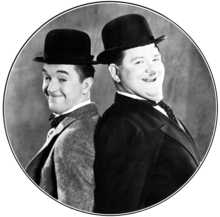We live in the fast-paced if moderately illiterate age where the tech-gulf between generations continues to widen. So it is only natural that I write about the cultural importance of a cinematic comedy team whose last good movie was made in the 1930s. Indulge me this little trip down nostalgia avenue, and don’t worry, all the bad news the same hi-tech information machines churn out will be waiting for us all when we return.
Thanks to the timing of my birth coinciding with it happening in the second largest media market in the nation, I was exposed to the old films of Laurel and Hardy at an early and impressionable age. One of my brothers and I used to get up early on Sunday mornings (before Mass) because one of the local TV channels showed Laurel and Hardy movies. In the day, they called them “shorts” because they had a playing time of less than 30 minutes. In their original theatrical release, they were perfect as the warm up for the feature movie. In their reincarnation on local TV, their short time span allowed for plenty of commercials.
Laurel and Hardy made us laugh then, and I promise if you take the time to YouTube or Netflix some of these gems, you’ll laugh now. They were a different kind of comedy team. Usually the vaudeville blueprint called for a comedy duo to consist of one idiot/clown and one straight man. This was the model, in my humble opinion, lesser teams like Abbott and Costello followed dogmatically. In the 50s, Dean Martin and Jerry Lewis tweaked the format with the straight man being the romantic lead and the guy who gets the girl at the end of the movie.
Stan Laurel certainly was a genius at playing an idiot and his physical clownishness is thing to behold. But what made this team different was that the “straight” man, the “brains of the outfit” wasn’t all that much smarter than his partner. Oliver Hardy, a big man indeed, had perfect physical timing, moved with exquisite grace, and you knew from the very start there was no way he was going to get the girl at the end of any Laurel and Hardy movie.
They were also among the first cinematic stars who broke the “fourth wall” — looking directly at the audience in the movie theater or at the kids watching on TV when something extraordinary stupid might have just happened or just been said.
The transition from silent films to sound doomed many a movie star. Not so Laurel and Hardy, whose careers were enhanced by sound. Stan Laurel had this lovely British accent and personally created many gags involving a full-frontal assault on the English language. Oliver Hardy had a delicate Southern drawl and delightful singing voice.
But even as Ollie fumes in frustration over something stupid Stan has done, there is a strange kind of friendship between them. The current film “Stan and Ollie” captures this bond in a most remarkable and artful fashion in the way actors Steve Coogan as Stan and John C. Reilly as Ollie inhabit their characters. It’s a bittersweet film, picking up Stan and Ollie in career freefall, older, not any wiser, and trying desperately to be visible to their public and invisible to their creditors.
The Marx Brothers had the same kind of magical chemistry, but they shared the same DNA. Laurel and Hardy were thrust together by a producer who thought they might be good together after seeing them appear in separate movies. Stan Laurel was an English Music Hall clown semi-fresh off the boat and Oliver Hardy was a genteel man from the American South — and the rest was movie history. The movie about them, “Stan and Ollie” is a history of sorts as well — the history of a friendship enduring good times and bad times and an artistic partnership that, thanks to that same tech monster that dwells inside our smartphones, tablets, and smart TVs, can be enjoyed by new generations.
Is there a theological aspect to the art of Laurel and Hardy? Probably, if you worked at it, but I suggest you don’t. A professor of film studies might be able to write a thesis on how the award-winning Laurel and Hardy short “The Music Box” is a post-classical version of the Greek myth of Sisyphus. But you’d be better off just enjoying watching two idiots try to get a piano up several flights of impossible stairs.
Robert Brennan is a weekly columnist for Angelus online and in print. He has written for many Catholic publications, including National Catholic Register and Our Sunday Visitor. He spent 25 years as a television writer, and is currently the Director of Communications for the Salvation Army California South Division.
Start your day with Always Forward, our award-winning e-newsletter. Get this smart, handpicked selection of the day’s top news, analysis, and opinion, delivered to your inbox. Sign up absolutely free today!

